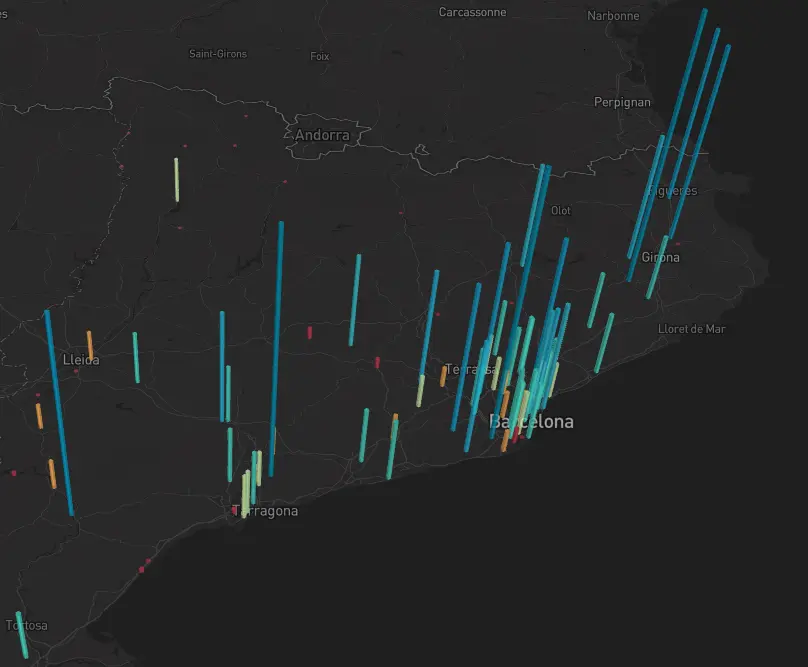Supporting the Apollo Link
At eRoots Analytics, we recently contributed to the Apollo Link project, a planned high-voltage direct current (HVDC) connection between Spain and Italy designed to strengthen Europe’s energy system and support the energy transition.
Our role was to analyse the Spanish grid to help determine where and how the link could best be integrated, ensuring it delivers its full potential without compromising the reliability of the system. Here’s a look at how we approached this challenge.
A data-driven approach to grid analysis
We based our assessment on our proprietary, high-resolution map of the Iberian transmission and sub-transmission networks. This model includes thousands of substations and power lines down to 66 kV, as well as HVDC links, and is continually updated to reflect both current infrastructure and planned developments.
For the Apollo Link study, we focused on four key tasks:
1. Understanding the current capacity
We started by analysing the official monthly capacity data published by the Spanish system operator. This helped us identify the technical limits of different substations, based on criteria such as:
- Short-circuit strength, which ensures the grid strength at the substation is adequate
- Static behaviour, which checks that generation doesn’t overload lines under normal or contingency scenarios
- Dynamic stability, which considers the system’s ability to stay synchronised and dampen oscillations during disturbances
This step gave us a clear view of the available hosting margins and the main constraints for connecting a new HVDC link.

2. Evaluating the impact of the HVDC link
Next, we used our model to simulate how a 2 GW HVDC connection would affect the surrounding grid under both normal and contingency conditions.

We began by establishing a baseline: analysing the existing power flows, line loadings, and redundancy of the network around the potential integration areas. This gave us a clear picture of how the grid operates today, including which lines already carry significant load and which have spare capacity.
We then introduced the HVDC link into the model and simulated its operation at full capacity, studying how the additional power injection or withdrawal would redistribute flows across the network. This step revealed which parts of the grid would experience higher stress, and whether any lines would approach or exceed their thermal limits.
In addition to evaluating the grid under normal conditions, we also assessed its behaviour under the so-called “N-1” scenario, where a single line or key component is assumed to fail. This is an essential test to ensure that the system can remain secure and avoid cascading failures even when an unexpected outage occurs.
Through this analysis, we identified potential bottlenecks and vulnerable sections of the network, which informed our recommendations on how to integrate the HVDC link while maintaining operational reliability and flexibility. We also examined how the grid’s meshing and redundancy would help absorb the additional power flows, providing valuable insights into the risks and trade-offs of different options.
3. Comparing alternatives
With the data from the first two tasks, we compared different options for integrating the HVDC link, focusing on their current performance and configuration.
We assessed each option based on immediate technical feasibility, examining factors like available hosting capacity, grid topology, and redundancy. Some alternatives offered higher capacity today but were more exposed to risks due to radial layouts or single points of failure, which could lead to significant curtailments during outages. Others, while having lower immediate margins, were embedded in more meshed parts of the grid, providing better resilience and operational flexibility.
We also looked at how each option interacted with existing infrastructure, identifying which configurations would minimise stress on critical lines and make best use of the current network without creating new bottlenecks. This allowed us to recommend options that optimised today’s capabilities while maintaining operational security.
4. Looking ahead
Beyond immediate feasibility, we examined how future developments in the Spanish grid would affect the integration of the HVDC link over time. We reviewed planned investments, such as upgrades to key corridors, new substations, and the scheduled retirement of older generation plants, all of which will reshape the grid’s capacity and behaviour in the coming years.
This analysis helped us identify which options are best positioned to benefit from these upcoming reinforcements and which might face challenges from competing projects or shifting demand patterns. It ensured that our recommendations were not just fit for the present but also aligned with the evolving landscape of the Spanish energy system, supporting long-term reliability and flexibility.
Building confidence in strategic decisions
Our analysis showed that a carefully chosen integration point, supported by existing and planned infrastructure, can accommodate a 2 GW HVDC link while maintaining system security and flexibility. This kind of work highlights the value of detailed, independent grid analysis when planning large infrastructure investments.
At eRoots, we’re proud to see our tools and expertise contributing to projects that strengthen Europe’s energy system and support the energy transition.
If you’d like to learn more about how we can help with similar studies, or about our Iberian grid map and modelling capabilities, feel free to get in touch.